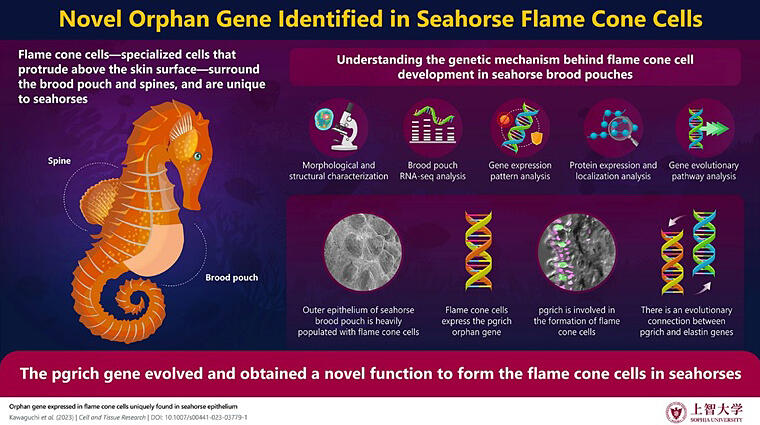Males of the fish family Syngnathidae, which includes seahorses, carry a brood pouch as an organ for brooding young. Male seahorses carry this brood pouch on their ventral side, where eggs received from females are incubated and the young are born. The body surface of seahorses is surrounded by morphologically characteristic cells called flame cone cells which protrude 20−40 µm from the surface and are covered with a mucous coat.
A research team comprising Associate Professor Mari Kawaguchi and Professor Shigeki Yasumasu of the Department of Materials and Life Sciences at Sophia University and researchers from Tokyo University of Agriculture and the University of Tokyo has revealed that a new gene, which lacks homologs in other lineages, is expressed in the flame cone cells that cover the surfaces of the spines and the brood pouch of seahorses. The results were published online in Cell and Tissue Research.

The research team first performed histological observations to confirm the presence of flame cone cells in the outermost layer of the seahorse epidermis. However, the presence of flame cone cells could not be confirmed in the barbed pipefish (Urocampus nanus) and the seaweed pipefish (Syngnathus schlegeli), both of which belong to the same family (Syngnathidae) as the seahorse.
Next, RNA sequencing analysis of the pot-bellied seahorse (Hippocampus abdominalis), a member of the seahorse family, led to the discovery of an orphan gene. This gene was named the proline-glycine rich (pgrich) gene because its transcript contains proline- and glycine-rich amino acid sequences. In situ hybridization and immunohistochemical analyses of the expression pattern of this pgrich gene revealed that it is expressed in the flame cone cells on the surface of the brood pouch.
Furthermore, analysis of the amino acid sequence of the pgrich protein revealed that the sequence is somewhat similar to the one obtained when the complementary strand of the elastin gene is translated to amino acids. These results suggest that the pgrich gene may have originated from a part of the elastin gene through the involvement of transposable and retroposable elements.
To find orthologs (genes in different species that evolved from a common ancestral gene through speciation) of the pgrich gene, the genome sequences of eight species of the order Syngnathiformes and seven species of other orders of Teleost were analyzed. As a result, the pgrich gene was found only in the genera Hippocampus and Syngnathus. This suggests that the pgrich gene originated in the common ancestor of these two genera.
Kawaguchi explained, "Fishes of the family Syngnathidae such as Hippocampus coronatus (seahorse) and Syngnathus schlegeli are unique animals in that it is the males that incubate the eggs, received from females, inside a brood pouch and give birth. However, it is not clear how the brood pouch arose during the evolutionary process of these fish. Given that the pgrich gene discovered in this study is expressed on the surface of the brood pouch, it is possible that this gene has some role in the formation of the pouch. Clarifying the evolutionary process of the pgrich gene will provide clues to clarify the evolution of orphan genes that arise specifically in certain lineages."
Journal Information
Publication: Cell and Tissue Research
Title: Orphan gene expressed in flame cone cells uniquely found in seahorse epithelium
DOI: 10.1007/s00441-023-03779-1
This article has been translated by JST with permission from The Science News Ltd. (https://sci-news.co.jp/). Unauthorized reproduction of the article and photographs is prohibited.




